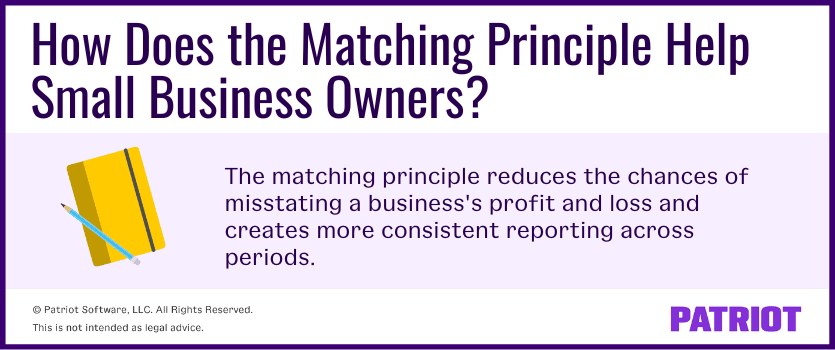If you’ve ever sent an invoice to someone who planned to pay later, you’re probably using accrual accounting. It can be hard to keep track of finances when you’ve accrued payables and liabilities. But, using the matching principle can help you stay organized. The matching principle in accounting states that you must report expenses in the same period as related revenues.
So, what is the matching principle in accounting? Read on to learn more about the matching principle.
Accrual accounting and the matching principle
Accrual-based accounting is one of the three accounting methods you can use as a small business owner. The two other accounting methods are cash-basis and modified cash-basis accounting.
The accrual method of accounting requires you to record income whenever a transaction occurs (with or without money changing hands) and record expenses as soon as you receive a bill. In action, you might record income long before you receive payment. The matching principle operates alongside accrual accounting. With the matching principle, you must match expenses with related revenues and report both at the end of an accounting period.
With the help of adjusting entries, accrual accounting and the matching principle let you know what money is available for use and helps keep track of expenses and revenue.

What is the matching principle in accounting?
You may be wondering, How does the matching principle work? The matching principle (also known as the expense recognition principle) is one of the ten Generally Accepted Accounting Principles (GAAP). And, the matching principle is the driving force of accrual accounting.
The matching principle states that you must report an expense on your income statement in the period the related revenues were generated. It helps you compare how much you made in sales with how much you spent to make those sales during an accounting period.
The matching principle offers small business owners two key benefits:
- It minimizes the chances of misstating a business’s profit or loss in a reporting period
- It creates more consistent reporting of profits across periods, reducing large fluctuations in a business’s financial statement
How does the matching principle work?
The matching principle often works through adjusting entries. You must use adjusting entries at the end of an accounting period to ensure your business’s revenues and expenses are accounted for correctly.
Both adjusted entries and the matching principle help organize information already in your books. But, neither are retroactive. In other words, you don’t need an industrial-grade eraser to make an entry. Instead, you’ll simply make a new entry with the latest information.
The matching principle depends on the type of expenses your business has incurred:
- If the expense directly relates to generating revenue, account for the expense in the same reporting period the revenue is generated.
- If the expense indirectly relates to generating revenue, account for the expense whenever the expense takes place.
Matching principle examples
Matching lets you book expenses that directly connect to revenue and that indirectly affect revenue. For instance, the matching principle works equally well when booking employee wages as it does with equipment depreciation.
Here are three things to remember about the matching principle:
- Book expenses directly tied to revenue production in the same period the revenue occurred
- Book expenses indirectly linked to revenue production in the current period
- Expenditures lasting more than a year should be spread across the asset’s useful life
The first question you should ask when using the matching principle is whether or not your expenses are directly or indirectly related to generating revenue. The answer will change the way you apply the matching principle.
1. Expenses directly related to generating revenue
Several types of expenses directly generate revenue, such as wages, electricity, and rent. Without these expenses, you wouldn’t be able to operate your business.
Whenever an expense is directly related to revenue, record the expense in the same period the revenue is generated.
Let’s take a look at this in action. Two examples of the matching principle with expenses directly related to revenue are employee wages and the costs of goods sold.
Employee wages
Imagine a company that manufactures teacups, Sippin Pretty Inc. Sippin Pretty pays its employees $19 an hour to produce their signature teacups. Luckily, Sippin Pretty just sold all of the teacups recently produced by its employees.
Because the payroll costs led directly to the revenue generated by selling the teacups, Sippin Pretty should expense the payroll costs in the current period.
Cost of goods sold
Let’s say a local shop buys 100 units of a product for $100 each to sell at $300 each. The local shop purchased the items in August and can’t manage to sell them until September. As long as the products sit in inventory, no revenue exists. In this case, there’s no need for the matching principle. Luckily, the products sell out on September 5th for a revenue of $6,000.
Because the items generated revenue, the local shop will match the cost of $1,000 with the $6,000 of revenue at the end of the accounting period. So, the expense and the revenue will be booked in September, when the revenue was generated.
2. Expenses indirectly related to generating revenue
There are times when it’s harder to understand if expenses generate revenue or not. In those cases, you probably have expenses indirectly linked to revenue, like employee bonuses.
Employee bonuses
Another example of the matching principle is how to properly record employee bonuses, a type of expense indirectly tied to revenue.
For example, the sales team has met all of its annual goals. Team members will receive a $1,000 bonus next year on March 15th, 2023. Since the expense is only indirectly related to revenue, the matching principle requires that the company records the bonus expense before the new year.
3. Expenditures lasting more than a year
Certain assets like equipment or vehicles can depreciate over time, meaning that their value changes as a result of wear and tear and aging. As it depreciates, an asset is still indirectly linked to generating revenue. Because you need to keep track of the depreciation of an asset over a certain period, accounting for the change in value can be tricky.
The depreciation of land or equipment
Let’s look at an example of how the matching principle helps a company understand the indirect costs of a new piece of equipment that depreciates over time.
The ABC Farm just bought a new tractor for $100,000. ABC Farm expects to use the tractor to harvest for 10 years. The matching principle in accounting states that ABC Farm must match the cost of the tractor with the revenue it creates, even as it depreciates.
The cost of the tractor is charged to depreciation expense at $10,000 per year for ten years. This takes place every year as the tractor’s value changes each year.
The matching principle is a great way to keep accurate books, but Patriot’s accounting software takes accuracy to a whole new level. With Patriot, you can easily manage asset, liability, equity, income, and expense accounts. Start your free trial now!
This is not intended as legal advice; for more information, please click here.



